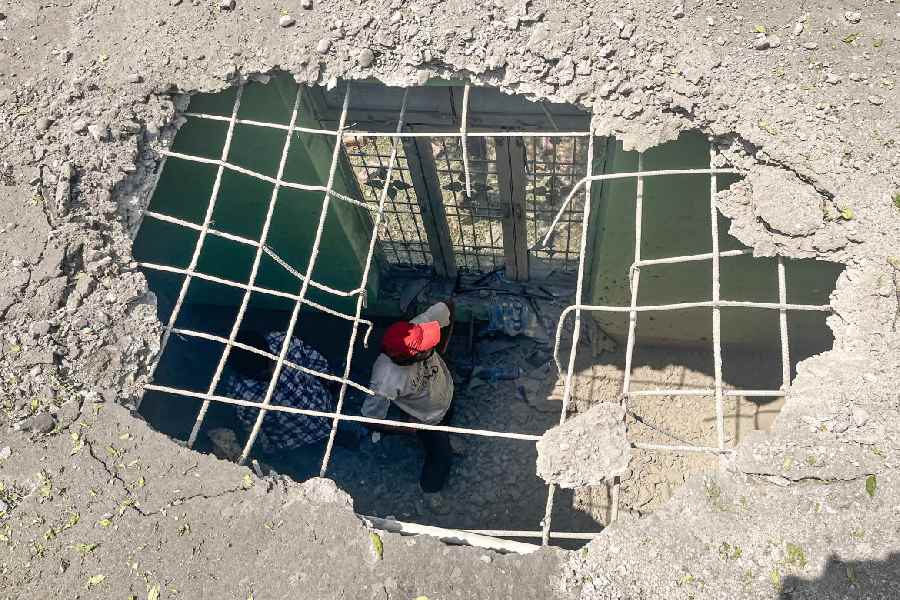 |  |
| A pot of Ber (kul) growing in the township. (Right) Ready-to-eat Bers on branches | |
Every year from Saraswati puja onwards the market fills up with Ber (kul). The trees flower in autumn and bear fruits at the end of winter, just in time for us to relish them on the puja.
The Ber is also called Chinese Date, Red Date or Indian Date and is an important remunerative minor fruit in India. It is the most hardy fruit tree cultivated all over the country and is often called the poor man’s fruit.
Scientifically called Zizyphas guguba, the plant belongs to the Rahmnaceae family, which is very close to the grape vitsceae family. About the nomenclature, this species has a curious history, thanks to botanical naming regulations and variations in spelling.
In 1753, Carlus Linnaeus described the Ber as Rhamnus zizyphus. Later Philip Miller in 1768 concluded it was distinct from Rhamnus and named it Ziziphus jujuna using the same genus as Linnaeus but perhaps with an accidental spelling difference — ‘i’ for ‘y’. For the species he used a different name.
The Indian Ber, scientifically known as Ziziphus mauritiana, is different from Chinese Ber (Ziziphus juguba). It is a small deciduous tree reaching up to a height of 10m, usually with thorny branches. Its leaves are shiny green on the upper surface and the fruit is oval drupe of 1.5 to 3cm depth. When immature it is smooth green.
Cultivation: Ber grows under varying climatic conditions all over India even at an elevation of up to 1,000m above mean sea level. But regular plantations are few and so there are no accurate statistics about the area under Ber cultivation in India.
The tree tolerates a wide range of temperature and rainfall though it requires hot summers and sufficient water for acceptable fruiting. The Ber is not particularly exacting its soil requirement. It can grow on a wide variety of soils - sandy or clayey. Some varieties withstand salinity in soils too. The trees shed leaves and enter dormancy during the beginning of summer and are extremely drought-hardy. This is because of its deep root system and other xerophytic characteristics. The tree prefers atmospheric dryness for developing good quality fruits.
The beginning of monsoon is the best time for planting Bers. Pits of 60cm×60cm×60cm are to be dug during summer and refilled after mixing 25kg of farmyard manure and 1kg of superphosphate and 250g of potash with required quantity of soil.
In orchards, planting is done at a spacing of 6m to 8m. In Salt Lake, it is grown as an isolated plant either in the backyard or in the open space in front of the house.
Varieties: Several varieties are cultivated in different parts of India. In West Bengal varieties like Narikeli, Benarasi Prolific, Baruipur, Ghughudanga etc. are cultivated. Besides, other varieties like Banarasi Karka, Narma, Thornless, Gola, Safed Selected, Reshmi and Illachi etc. are cultivated in U.P., Bihar, Gujarat, Andhra Pradesh, Rajasthan, Tamil Nadu and Maharashtra.
Propagation: Seedling plants are poor in both productivity and fruit quality. The most common method of Ber propagation is by shield budding.
Root stock seedlings could either be transplanted in the field during July and August for in situ budding or can be budded in the nursery beds. The budlings can be transplanted in bare root condition between January and March. The scion bud wood should always be collected from elite trees known to bear heavy yield with good quality fruit.
After-care and fertilisation: Although Ber is a very hardy tree and Ber orchards are seldom manured, its productivity can be improved if manuring is done every year. The dose depends on the fertility status of the soil. In general, a dose of 15kg to 20kg of well-rotten cowdung or farmyard manure with 250g of phosphate increases fruit yield.
Annual pruning is essential for Bers. This would induce maximum number of new healthy shoots to bear good quality fruits. The undesirable, weak, diseased and broken branches should be removed to encourage healthy growth for maximum fruit bearing. Pruning is done during the hot and dry season when the tree enters dormancy.
Harvesting: Fruits should be harvested at optimum stage of maturity as immature fruits do not mature after picking. Such fruits are not sweet enough and remain acrid in taste. Maturity of fruits is usually judged by external colour.
Depending upon variety, some Bers are harvested when mature-green or mature-golden-yellow in colour. Fresh fruits are rich in vitamin C, A, B Complex and minerals.
Uses: The mouth-watering fruits are eaten raw. Ber fruits can be stored in a net bag at ambient room temperature (25°C to 30°C) for 4-10 days. Juicy fruits of Ber are used for making squash, jam, beverages etc. In Bengal, pickle and chutney made of Ber are very popular.
To be continued
Send your gardening queries to saltlake@abpmail.com










